Apollo 10
Day 8, part 35: Entry Preparations
Corrected Transcript and Commentary Copyright © 2018-2022 by W. David Woods, Robin Wheeler and Ian Roberts. All rights reserved.
Last updated 2022-02-14
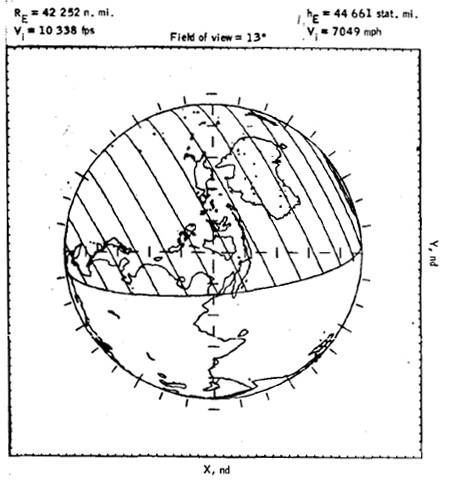
The view of the Earth from Apollo 10 at 187:00:00.
187:03:22 Stafford: Roger. Tell all the people around the world, Jack, and also in Houston, MCC, what a great job they've done, and we'll see them back there shortly. Over.
187:03:31 Lousma: Roger, Tom. Thank you and their congratulations to you and your crew. Over.
187:03:36 Stafford: Roger. We'll wait until we get onboard the carrier for that.
187:08:28 Cernan: Hello, Houston. This is 10. Do you want me to maintain High Gain for you until after the update?
187:08:41 Lousma: That is affirmative, 10. We prefer the High Gain for the update.
187:09:17 Lousma: And, Apollo 10, Houston. I have some attitudes for P52.
187:09:23 Stafford: Stand by. We're still doing some stowing here. Go ahead and give me a rough one, Jack.
187:09:29 Lousma: Roger. The P52 - We have two attitudes. Probably the preferred is the one I'll read first and if you want another one, I'll give it to you.
187:09:40 Stafford: Go ahead.
187:09:41 Lousma: Roll, pitch, and yaw are all balls, and your stars are Menkent, number 30, Atria, number 34, and Nunki, number 37.
187:09:57 Stafford: Roger. Roll, pitch, and yaw all balls, stars 30, 34, and 37.
This is Apollo Control at 187 hours, 11 minutes Ground Elapsed Time. Apollo 10 now 36,136 nautical miles [66.924 km] out from Earth. Velocity continuing to build up; now 10,709 feet per second [3,264 m/s]. Estimated velocity at Entry Interface, or 400,000 feet [121,920 metres] above the surface; 36,314 feet per second [11,070 m/s]. Ignition time for midcourse correction number 7, 1 hour and 37 minutes away. Entry Interface 4 hours, 36 minutes away.
187:12:43 Stafford: Houston, Apollo 10. I'll stay in this attitude until you give us the update, and then we'll go down to zero, zero, zero. Over.
187:12:50 Lousma: Roger. We copy, 10.
187:13:33 Lousma: Apollo 10, Houston. We're ready with your update. We've got a state vector and entry REFSMMAT and a midcourse 7 target load, and if you will go to Accept. In addition, we're not reading anything on the VHF yet, and we'd like you to ensure that the VHF is cranked up. Over.
187:13:58 Stafford: OK, Houston. Apollo 10. We are in P00 and Accept. I've got the VHF warming up and we'll give you a call in just a minute. Over.
187:14:07 Lousma: Roger, 10.
187:14:37 Stafford: Hello, Houston. This is Apollo 10 on VHF A Simplex. How do you read? Over.
187:14:44 Lousma: Roger. I hear you loud and clear, 10, on VHF A.
187:14:47 Stafford: Roger, Houston. This is 10 reading you loud and clear. Over.
187:14:58 Lousma: Belay my last, 10. I think I'm getting you on S-band. We'll check with the VHF people. [Long pause.]
187:15:54 Lousma: Apollo 10, Houston. Carnarvon reads you loud and clear on VHF.
187:16:00 Stafford: Roger, Houston. Apollo 10. I'm reading you about three-by-three on VHF. How me?
187:16:14 Lousma: Apollo 10, Houston. I'm reading you here on S-band, and we'll have to check with the sites to see how the VHF is coming in.
187:18:58 Lousma: Apollo 10, Houston. We're on VHF only. How do you read? Over.
187:19:10 Lousma: Apollo 10, Houston. How do you read on VHF? Over.
187:19:59 Lousma: Apollo 10, Houston. Back on the S-hand. Apparently you weren't reading us on VHF. We'll give you another VHF check in about a half an hour.
187:20:08 Cernan: OK, Jack. [Long pause.]
187:20:58 Lousma: Apollo 10, Houston. The uplink is complete. You can go to Block.
187:21:52 Stafford: Houston, Apollo 10. I'll go ahead and pitch down to 000 when you have everything the [garble] as far as the uplink is complete and verified. I guess it is verified now. Over.
187:22:07 Lousma: Roger. The uplink is complete, Tom, and you're clear to the new attitude.
187:22:12 Stafford: Roger, 10. And, Houston, 10. This attitude of 000 will be a good one to torque to the new REFSMMAT? Over.
187:22:24 Lousma: That's affirmative, 10.
187:31:56 Lousma: Apollo 10, Houston. We'd like you to go to wide beamwidth and High Gain Antenna and I have a maneuver PAD and an entry PAD for you.
187:32:06 Stafford: OK. We'll be with you in one second; I'm going to wide beamwidth right now.
187:32:18 Stafford: You're in wide, Houston, and we'll give you a call when we're ready to copy. We're still doing a few little chores here. Over.
187:39:27 Cernan: Hello, Houston, Houston. This is Apollo 10. We're ready to copy your P30 and your entry update.
187:39:35 Lousma: Roger, 10. Here's the maneuver PAD. MCC 7, RCS/G&N: 25232, Noun 48 is NA. Noun 33 is 188:49:56.75; plus three balls 16, minus all balls, minus four balls 1; three balls, 129, three balls; apogee is NA, perigee is plus 0021.2; three balls 16, two balls 7, three balls 16; 40, 295.9, 38.3; 033, Uniform 159, Lima 12. The rest is NA; your set stars are Deneb, 43; Vega, 36; 067, 174, 343. Your ullage is a two-quad burn, use Bravo and Delta. Read back maneuver PAD; let me know when you're ready with the entry PAD. Over.
187:41:37 Cernan: OK. MCC 7, RCS G&N: 25232; 48's NA; 188:49:56.2 - .75, plus three balls 16, minus all balls, minus four balls 1. Roll is 000, 129, 000. Apogee is NA; perigee is plus 0021.2, three balls 16, two balls 7, three balls 16; 40, 295.9, 38.3; 033, Uniform 159, Lima 12; Deneb, 43 and Vega, 36; 067, 174, 343. Using two quads, Bravo and Delta. And I'd like to read Noun 33 back to you again. That's 188:49:56.75.
187:43:04 Lousma: That's affirmative, 10. Entry PAD when you're ready.
187:43:11 Cernan: Im ready, Jack.
187:43:13 Lousma: OK. The entry PAD is a Mid-Pac: three balls, 153, 001; 191:31:54; 268; minus 15.07, minus 164.67; 06.8, 36315, 6.52, 1204.1; 36395; 191:48:54; 00:28; Noun 69 is NA; D0 is 4.00; 028 - correction, 02:08; 00:18, 03:29, 08:17; 40, 262.1, 34.7; 033, Dog 089, Lima 22. Lift vector is Up. Comment: Use a nonexit pattern. Your horizon is dark at Entry Interface. Over.
187:45:29 Cernan: OK. Jack. Entry PAD. Area is Mid-Pac: 000, 153, 001; 191:31:54; 268; minus 15.07, minus 164.67; 068, 36315 6.52, minus 1204.1; 36395; 191:48:54; 00:28; Noun 69 is NA. Are you still with me?
187:46:33 Lousma: That's affirmative. Go ahead.
187:46:35 Cernan: DO is 4.00; 02:08; 00:18, 03:29, 08:17; 40, 262.1, 34.7; 033, Delta 089 and Lima 22. The lift vector is Up; using a nonexit pattern and the horizon is dark at Entry Interface.
187:47:19 Lousma: Roger, 10. I have a late correction at the bottom. SPA is Dog 080, now. Over.
187:47:29 Cernan: Roger. SPA is 080.
187:47:37 Lousma: And, 10. We'd like you to read the range to go back, please.
187:47:47 Cernan: OK. The range to go is 1204.1.
187:47:54 Lousma: Roger. We copy. And that's affirmative.
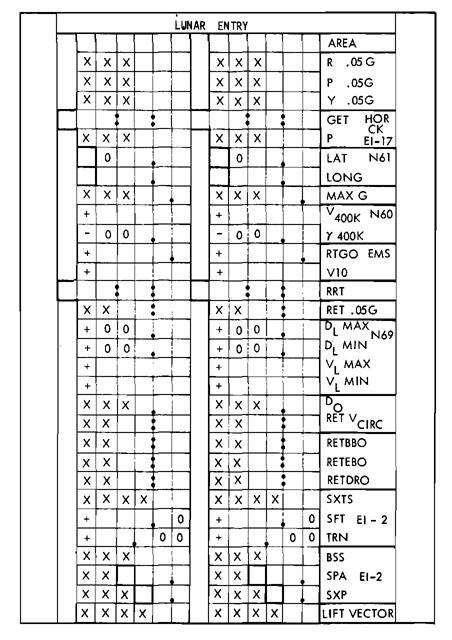
Form for copying down the Lunar Entry PAD.
187:51:XX This is Apollo Control. To translate some of the exchange of numbers between the spacecraft and the ground; they were passed up a maneuver PAD for midcourse correction burn number 7; will be with the RCS thrusters. At 188 hours, 49 minutes, 56.75 seconds, 1.6 foot per second [0.49 m/s] velocity change, burn time of 7 seconds. The additional - the other PAD for the entry numbers to the Mid Pacific prime recovery line, nominally along 165 west longitude, showing target point of 15.07 south latitude, 164.67 west longitude. Maximum gs expected, 6.8; velocity at 400,000 feet [121,920 metres] or Entry Interface, 36,315 feet per second (11,070 m/s]; flight path angle at 400,000 feet [121,920 metres], 6.52 degrees. The range to go at the time the Entry Monitor System is activated, 1,204.1 nautical miles [2,230.0 km]. Velocity at the time the Entry Monitor System is activated and the crew begins reading the onboard displays of range to go, steering commands and so on, 36,395 feet per second (11,093 m/s]. Begin blackout, 18 seconds after Entry Interface. End black out; 3 minutes, 29 seconds after Entry Interface. Drogue deploy; 8 minutes, 17 seconds after Entry Interface. They were also informed that the horizon would be dark at Entry Interface. Now 187 hours, 52 minutes Ground Elapsed Time. Showing 57 minutes, 40 seconds, mark, to ignition of midcourse correction burn number 7; 3 hours, 56 minutes, 28 seconds to Entry Interface. Distance now 31,956 nautical miles [59,182 km] out from Earth; speed continuing to increase to now reading 11,336 feet per second [3,455 m/s]. Continuing to monitor air to ground circuit for continuing conversation of Apollo 10 crew, with spacecraft communicator Jack Lousma here in Mission Control.
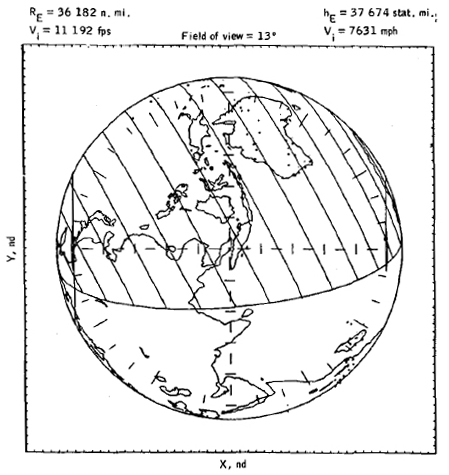
The view of the Earth from Apollo 10 at 188:00:00.
188:00:03 Lousma: Apollo 10, Houston. We know the set - the DAP is now set up for four jets, and we think we ought to have two jets. That'd be B and D. Over.
188:00:15 Stafford: OK. Roger. You want - Since it's only a couple of feet per second here and everything, we've got plenty of fuel, but well go ahead and use two jets. Our checklist calls for four. Over
188:00:31 Lousma: Roger, 10.
188:04:59 Young: Houston, this is 10. We're going into the cold soak in our checklist, there.
188:05:06 Lousma: Roger, 10. Copy.
188:11:35 Cernan: Houston, this is 10. What's your feeling about putting fuel cell 1 on for the burn?
188:11:40 Lousma: Stand by one.
188:11:59 Lousma: Apollo 10, Houston. We don't need fuel cell 1 for the burn and don't intend to use it for the burn. Over.
188:19:08 Stafford: Houston, Apollo 10. We're starting through our P30 series now. Over.
188:19:14 Lousma: Roger, 10.
188:22:24 Lousma: Apollo 10, Houston. We suspect that your suit circuit heat exchanger may be in the Bypass position and - well, for comfort, it ought to be on now, and go to Bypass at EI minus 50. Over.
188:33:46 Lousma: Apollo 10, Houston. When it's convenient, we'd like to get a GET time hack with you.
188:33:53 Stafford: It's convenient. Over.
188:33:56 Lousma: Roger. Go ahead and give us a time and we'll set our clocks.
188:34:04 Stafford: OK. It's 188:34, 5, 6, 7, 8, 9, 10, 11, 12, 13, 14, 15. Over.
188:34:17 Lousma: OK. Thank you very much. We're right on.
188:34:20 Young: That's computer time and GET time, and our mission time is right on.
188:34:25 Lousma: Roger. We're following right along with you.
188:37:39 Stafford: Houston, Apollo 10.
188:37:43 Lousma: Go ahead, 10.
188:37:46 Stafford: OK. We're going to go ahead and call up P41.
188:37:49 Lousma: OK. We'll be watching you.
This is Apollo Control, 188 hours, 39 minutes Ground Elapsed Time, coming up on 10 mark to the burn, Mark, 10 minutes to ignition of midcourse correction burn number 7, air-to-ground still live.
188:41:57 Stafford: Houston, Apollo 10. Would you give us a hack at 5 minutes prior to the maneuver just so we can recheck our event timer? Over.
188:42:06 Lousma: Roger. Understand you want a time hack just prior to the burn. Is that affirmative?
188:42:11 Stafford: Give us one at 5 minutes. This event timer occasionally has been jumping numbers. Over.
188:42:16 Lousma: Roger. We'll give you a hack at 5 minutes. That'll be about a minute and a half yet.
188:42:56 Young: OK, Houston. We're showing 7 minutes.
188:42:59 Young: How's that sound?
188:43:00 Lousma: Yes. We're showing the same. That's confirmed, 7 minutes.
188:47:06 Stafford: OK. We're proceeding here for the final trim.
188:47:12 Lousma: Roger, 10.
188:47:38 Young: Boy, this is absolutely fantastic. Come all the way back to the Moon and do this kind of midcourse.
188:47:47 Lousma: Yes. That's pretty good shooting, isn't it?
188:47:29 Young: Man, I mean to tell you.
188:47:55 Stafford: Tell Christopher C. and company looks like they have a pretty good rifle scope there to shoot us back in this target. Over.
188:48:02 Lousma: Roger. I guess all that mathematics really works after all.
188:48:08 Stafford: Roger.
188:48:51 Lousma: Apollo 10, Houston. We have a few configuration items we'd like to point out. Right...
188:48:58 Stafford: OK. We'll wait.
188:49:00 Lousma: Rotational hand controller power, Direct; BMAGS, Att 1, Rate 2. Over.
188:49:24 This is Apollo Control. Mark, 30 seconds to ignition.
188:49:58 Stafford: We're burning.
188:50:26 Stafford: OK. How we are on our residuals? You can read them? 0, minus 1, minus 1, and a Proceed.
188:50:33 Lousma: Roger. We copy.
188:51:21 This is Apollo Control. Midcourse correction burn number 7 scheduled for 7 seconds duration, was actually burned out at 6.6 seconds.
188:53:02 Stafford: Houston, Apollo 10. It's starting to get real cool in here. We'd like to go Bypass on the suit circuit heat exchanger. Over.
188:53:18 Stafford: And we can turn it on if it gets warm again. Over.
188:53:24 Lousma: Roger, 10. Go ahead.
188:53:28 Stafford: Bypass.
188:54:12 Cernan: Hello, Houston. This is 10. Could you give me a short count, and I'll cut off my S-band and see whether I can pick you up on VHF?
188:54:21 Lousma: Stand by one, please.
188:55:04 Lousma: Apollo 10, Houston. We'll try a VHF voice check as soon as we get the sites configured and you can go to left antenna. Over.
188:55:16 Cernan: OK. Thank you, Jack.
188:56:47 Lousma: Apollo 10, Houston. Set up your VHF and S-band turned down. We're going to try the VHF check in a minute.
188:57:08 Lousma: Hello, Apollo 10. Houston on VHF through Guam. How do you copy? Over.
188:57:20 Lousma: Apollo 10, Houston. How do you read? Over.
188:58:11 Lousma: Apollo 10, we're back up on S-band. We weren't able to read you on VHF. Over.
188:58:18 Young: Roger. We heard some kind of transmissions there in the background, but we never gave you a call on VHF. Over.
188:58:27 Lousma: Roger. I asked for a radio check on VHF. Apparently we're not quite in range yet.
188:59:24 This is Apollo Control. Apollo 10 now 24,469 nautical miles [45,317 km] out from Earth; velocity now 12,794 feet per second [3.900 m/s]. Still monitoring air to ground, live.
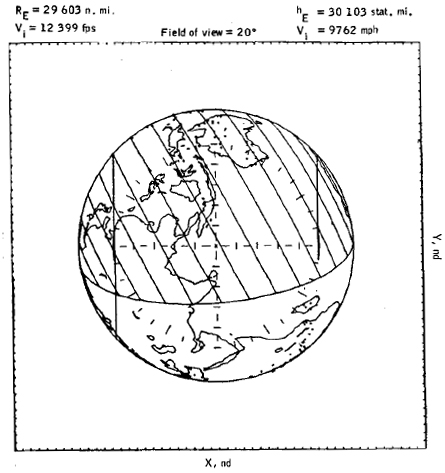
The view of the Earth from Apollo 10 at 189:00:00.
189:00:06 Lousma: Apollo 10, Houston. All sites are monitoring VHF downlink. When you're ready, make a transmission and they'll see if we can pick you up.
189:00:15 Stafford: Roger, Houston. This is Apollo 10 transmitting on VHF on the short count. 5, 4, 3, 2, 1. How do you read? Over.
189:01:57 Lousma: Apollo 10, Houston. Sites apparently aren't reading you yet on VHF. We recommend that you transmit simultaneous S-band and VHF; and, when the sites can read VHF, why, they'll let us know, and we'll conduct the radio check. Over.
189:02:10 Young: Roger. That's what we're doing. Over.
189:02:19 Stafford: OK, Houston, Apollo 10. We're all squared away and way ahead on the checklist. The next thing we're waiting for is just to read out the Command Module RCS temps and service the primary Evap and the logic check coming up. Over.
189:02:35 Lousma: Roger. And there's no significant change in the weather in the landing area. The altimeter is 29.88, or plus 38 feet, and we have a splashdown computed time of 192:03, and sunrise will be 25 minutes later. Over.
189:02:58 Stafford: Roger 192:03, sunrise 25 minutes later. Thank you.
189:03:04 Lousma: Roger. And you copy altimeter 29.88.
189:03:08 Stafford: Roger.
189:03:13 Young: Hey, Jack, we don't have any place to set the altimeter. But thanks for the plus 38 feet.
189:03:19 Lousma: Roger. Plus 38.
189:03:37 Lousma: And, 10, we're ready for your RCS temps when you're ready to read them down.
189:04:37 Cernan: Houston, here's our readings: 5-Charlie is 5.0; 5-Delta is 4.8; 6-Alpha is 5.1; 6-Bravo is 5.1; 6-Charlie is 4.2; 6-Delta is 4.9.
189:05:24 Lousma: Roger, 10. We copied the temperatures. Thank you.
189:07:12 Young: Houston, at 45 minutes to EI - to RRT time Could you give us a time hack? Over.
189:07:20 Lousma: Roger. You want a time hack at 45 minutes to EI.
189:07:24 Young: That's affirmative.
189:07:25 Lousma: And your computer landing time precisely is now 192:03:57.
189:07:47 Young: Houston, we're going back On with the suit circuit heat exchangers. It doesn't take very long.
189:07:53 Lousma: Roger to On.
189:08:39 Lousma: Apollo 10, Houston. Late correction on your landing time is 192:02:57.
189:08:52 Young: [Laughter.] Roger. 192:02:57.
189:08:59 Lousma: Buddy, you're going to get there. It doesn't really matter does it?
189:09:08 Young: Yes. We'll get back.
189:09:09 Lousma: Yes. We could put you in a holding pattern for a minute there, maybe.
189:09:18 Young: As long as our RET times are OK, we're in good shape.
189:09:28 Stafford: Houston, Apollo 10. Over.
189:09:30 Lousma: Go ahead.
189:09:32 Stafford: Roger. Wish you would relay on to Captain Cruse, the skipper of the Princeton, that at the time there, at 192:03, we expect to be right on top of the aim point and hope this big ship is close by. Over.
189:09:47 Lousma: Roger. We'll pass the word on, and you just holler "Meat Ball" when you see it.
189:09:53 Stafford: Will do.
189:10:38 This is Apollo Control. To recap that last exchange, predicted touchdown time, in Ground Elapsed Time 192 hours, 2 minutes, 57 seconds. Back to air to ground.
189:13:08 Young: OK, Houston. Our data up here shows no preheat.
189:13:19 Lousma: Roger. We confirm that, 10.
189:18:53 This is Apollo Control. Mark; 2 hours, 30 minutes to Entry Interface, or sensible atmosphere at 400,000 feet (121,920 metres] above the surface. Apollo 10 now 22,150 nautical miles [41,022 km] out from Earth. Velocity beginning to increase - air to ground here.
189:19:11 Cernan: Houston, this is 10. The glycol Evap water-flow valve will come on in two zero minutes.
189:19:20 Lousma: Roger. Two zero minutes.
189:19:22 Cernan: I'll leave it On for 3; then to Auto. Is that correct?
189:19:33 Lousma: That's affirmative, 10.
189:19:36 Cernan: OK. Thank you.
189:19:42 Velocity now 13,399 feet per second [4,084 m/s], beginning to build up as they get back closer into Earth - air to ground still live.
189:21:25 Lousma: Apollo 10, Houston. We would like to have all heaters and fans Off in the Cryo tanks. Over.
189:21:33 Young: Roger. Heaters and fans going off in the Cryo tanks.
189:21:44 Young: They're all Off.
189:23:05 Cernan: Houston, the Evap servicing is complete, and for the record, of course, we had been there before, but I had gone to Manual Increase again on the valve.
189:23:15 Lousma: Roger. We copy, and Manual Increase.
189:23:20 Cernan: And I know I've got the water flow in Auto.
189:23:24 Lousma: Roger, Gene.
189:23:35 Cernan: Houston, this is 10.
189:23:38 Lousma: Go ahead, 10.
189:23:47 Lousma: Apollo 10. Houston. Go ahead.
189:23:50 Cernan: Roger. We're requesting an in-route descent commencing 1200 Out, and we'd also like expeditious handling, CCA down near the Princeton. We'll be making a vertical descent from about 24,000 (ft, 7,300 metres]. And request No Go-around this pass.
189:24:08 Lousma: Roger. Report crossing 25 miles (40 km) at 6,000 [ft, 1,800 metres]. Over.
189:24:18 Young: How about that? Houston approach hasn't changed a bit.
189:24:23 Stafford: We hope on this one, Houston approach at 6,000 [ft, 1,800 metres] will be within about a half to a quarter of a mile [0.8 to 0.4 km]. Over.
189:24:31 Lousma: Roger. You can write your deviation up when you're on the ground.
189:24:36 Stafford: Roger.
189:38:27 Cernan: Hello, Houston. 10. What's our range to Mother Earth?
189:38:34 Lousma: OK, 10. We're reading 19,660 [nautical miles, 36,410 km] at this time.
189:38:42 Cernan: OK. And how fast we going?
189:38:45 Lousma: You're coming in about 14,100 feet per second [4,300 m/s] right now. You're really picking it up.
189:38:52 Cernan: Thank you, sir.
189:39:19 Young: It's that last 10,000 miles (18,520 km) that's more interesting anyway.
189:40:11 Stafford: Hello, Houston. Apollo 10. Over.
189:40:13 Lousma: Go ahead, 10.
189:40:25 Lousma: Apollo 10, Houston. Go ahead.
189:40:28 Stafford: Roger, Houston. We still have lots of propellant in our primary propellant tanks, but we wanted to know, for the Service Module jettison, if you want us to open the secondary propellants. Over.
189:40:39 Lousma: Stand by one, please.
189:40:54 Lousma: Apollo 10, Houston. Proceed as per the checklist. Over.
189:40:59 Stafford: Roger. As per checklist.
189:47:57 Young: OK, Houston. We're ready for the logic sequence check now.
189:48:07 Lousma: Stand by one, Apollo 10.
189:48:18 Lousma: OK, Apollo 10. We're ready to go with the check. Over.
189:48:43 Young: OK. The ELS logic is coming on. ELS going to Auto. SECS logic is coming on. OK. We're all set up.
189:49:05 Lousma: Roger. 10. Stand by.
189:49:14 Lousma: OK. Apollo 10, Houston. We'll give you a Go for Pyro Arm.
189:49:21 Young: Roger. SECS logic coming back off.
189:53:53 Young: Houston, this is 10. We completed the sextant star check and Altair was within about 6 minutes of being right in the middle of the optics.
189:54:06 Lousma: Roger We copy, 10.
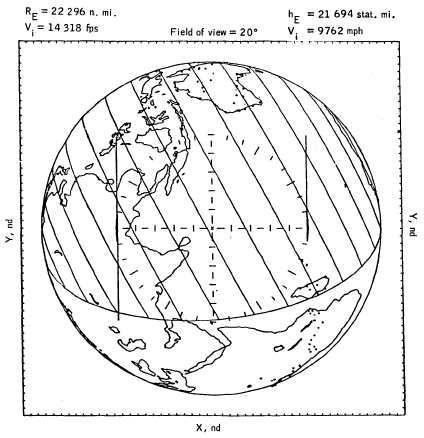
The view of the Earth from Apollo 10 at 190:00:00.
190:03:39 Cernan: Hello, Houston. This is 10.
190:03:41 Lousma: Go ahead, 10.
190:03:44 Cernan: Do you want to remain High Gain here until just before Sep?
190:03:50 Lousma: Stand by one.
190:04:23 Lousma: Apollo 10, Houston. Let's stay in High Gain until Sep and then go to Sep C. Over.
190:04:30 Cernan: OK. That's Sep Charlie; is that right, Jack?
190:04:35 Lousma: Sep Charlie at Sep. Let's stay in High Gain until that time. Over.
190:04:39 Cernan: OK. Fine. Thank you.
190:11:24 Lousma: I think you're lucky there in a Noun 05.
190:11:30 Stafford: Wait until you see the next one.
190:13:29 Stafford: How about that, Jack? Over.
190:13:33 Lind: That's not bad for a young fellow.
190:13:37 Lousma: OK. You proved a point.
190:13:40 Stafford: I told you. Wait until the next one.
190:13:44 Lind: You're just a show off; that's all.
190:13:49 Stafford: How about that, Don?
190:13:52 Lind: Those ain't bad.
190:13:53 Stafford: José can work with those optics.
190:13:57 Lind: Who's doing that, you or José?
190:14:01 Stafford: No. That's José; I'm just narrating here.
190:16:24 Lousma: Apollo 10, Houston. Our tracking data now shows you right in the middle of the fairway with a 6.53-degree entry angle. Over.
190:16:34 Stafford: Roger. Right in the middle of the corridor with 6.53. Roger.
190:23:32 Stafford: Houston, we checked Noun 61 and it looks loaded correctly now.
190:23:40 Lousma: Roger, 10. We're checking it.
190:23:40 Young: Roger. Our sextant - our alignment check sextant star on Nunki - the Auto optics put the star within the center of the reticle.
190:23:58 Lousma: Roger. Copy, John.
190:25:10 Lousma: Hello, 10. Noun 61 looks good to us.
190:25:15 Stafford: Alrighty.
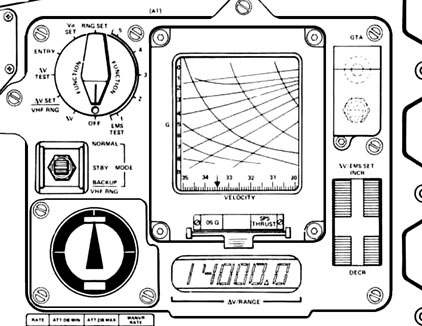
EMS panel.
190:28:42 Young: OK, Houston. EMS tests passed successfully.
190:28:48 Lousma: Roger. EMS. Thank you.
190:29:30 Young: OK. Houston, as I was driving the scroll down to - down to the pattern, the thing stopped scribing.
190:29:41 Lousma: Roger. She stopped scribing.
190:29:44 Lind: Say again, John.
190:29:47 Young: I say, the EMS stopped scribing as I was driving it down to the test pattern to set it up on the exit range.
190:29:57 Lind: Oh, you mean driving it down to 37 K?
190:30:01 Young: Yes. I can't get this one. I say it stopped scribing.
190:30:08 Lind: You say the needle's not scraping, or it's not driving in this tape?
190:30:14 Young: It's not - the tape is driving, but the needle is not leaving any mark.
190:30:18 Lind: Understand.
190:30:21 Young: I believe I'll go ahead and run it on down here anyway.
190:30:27 Lind: You might as well.
190:30:32 Young: Get some gs on it; it might work OK.
190:30:36 Lind: It's worth a try.
190:31:18 Young: OK. We're set up at 37 K.
190:31:22 Lousma: Roger. Maybe it'll come back in.
190:31:24 Young: On a non-exit pattern. [Long pause.]
190:32:01 Cernan: Houston, this is 10. Have I got a Go to activate the primary Evaps?
190:32:07 Lousma: Standby one.
190:32:13 Lousma: 10, Houston. Activate the primary Evaps.
190:32:17 Cernan: OK. Here goes.
190:37:56 Young: OK. Houston, we are going to maneuver to the Sep attitude now.
190:38:00 Lousma: Roger. Maneuvering to Sep attitude.
190:40:19 Lousma: Apollo 10, Houston. John, if you haven't already tried it, you might, on that EMS scroll, try running the tape back a half inch backwards and back and forth between the 37K line, and if that doesn't work, why, you can try the next pattern, and maybe this will break up that emulsion a little bit.
190:40:56 Young: Roger. Understand. Run the scroll back and forth between where and where? Over.
190:41:02 Lousma: Make sure you run it backwards first, backwards no more than half an inch, and then forwards no more than the 37K line. Over.
190:41:44 Young: By golly, that fixed it. Good thought there. What I did was I had it on range set, I went back to test 5. Does that mean that I have to go all the way through the EMS counterclockwise anymore, or if I go to range set, will it still be initialized at 37K. Over.
190:42:09 Lousma: Roger, John. Say again how far back you went please.
190:42:12 Young: About three-eighths of an inch.
190:42:21 Lousma: Stand by one. [Long Pause.]
190:42:55 Cernan: Hello. Houston. This is 10.
190:42:57 Lousma: Go ahead.
190:42:59 Cernan: Roger. We're getting a lot of noise on the High Gain in this Sep attitude. How about me going to Sep at this time?
190:43:05 Lousma: Stand by.
190:43:15 Lousma: Apollo 10, Houston. Let's go to Sep Charlie by the checklist. Over.
190:43:33 Cernan: OK. We'll hold off on it, then; but it's awful noisy up here.
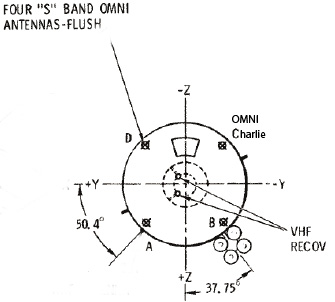
CM Omni antenna locations.
190:43:50 Stafford: OK. Houston, we're going back to the initial Entry Interface attitude. This noise is about to drive us wild up here on that High Gain.
190:43:58 Lousma: Roger, 10. It's OK to go Sep Charlie, now, if you'd rather.
190:44:04 Cernan: OK. We can go there now, huh? OK. Because we're a little bit ahead of the checklist in going into this attitude. That's why I asked. OK. We'll go to Sep Charlie at this time.
190:44:59 Lousma: Apollo 10, Houston. It's not clear to us exactly what you did with the EMS. Will you describe it one more time so we can give you an answer? Over.
190:45:07 Young: Roger. I was on Range Set when you said wiggle it back and forth, so I went back to test 5 and brought it back approximately three-eighths of an inch toward 38K, and it started scribing. So I quit and went back to 37, and I'm now on test 5.
190:45:27 Young: My question is...
190:45:32 Lousma: Go ahead with your question.
190:45:35 Young: Do I have to go through another scroll pattern or go clean through the EMS test to get it reset at 37K?
190:45:43 Lousma: Roger. We'll get an answer for you in just a minute.
190:45:49 Young: I think the answer is no.
190:45:58 Lousma: Apollo 10, while we're coming up with that answer, we're ready to uplink a state vector. Can we have the computer? Over.
190:46:13 Stafford: We're in CMC and Accept.
190:46:15 Lousma: Roger. Thank you.
190:47:30 Lousma: Apollo 10, Houston. We're a little delayed on our uplink. It'll be up momentarily. It's coming now.
190:48:50 This is Apollo Control. Mark 1 minute to Entry Interface at which point the Apollo 10 will come back into the, effectively, the Earth's atmosphere at 400,000 feet [121,920 metres].
190:49:05 Lousma: Apollo 10, Houston. I have an update to your entry PAD. There are only five numbers that are different than the last PAD. Over.
190:49:15 Cernan: OK, Jack. Take them one at a time, will you? And let me confirm them would you?
190:49:26 Lousma: OK. Our gamma at 400K is now 6.54. Over.
190:49:37 Cernan: 6.54 gamma at 400K.
190:49:42 Lousma: That's affirmative, and our RET at 0.05g is 00:27.
190:49:54 Cernan: 00:27 at 4 - 0.05g, RET.
190:50:07 Lousma: OK. That's affirmative. And the next three numbers are in the blackout block. Begin blackout at 00:17, end at 03:28, and drogues at 08:16, Over.
190:50:32 Cernan: OK. I got begin blackout at 00:17, and blackout at 3:28, and drogues at 8:16.
190:50:43 Lousma: That's affirmative.
190:50:46 Cernan: Thank you.
190:50:51 This is Apollo Control. To correct statement earlier in reading the clock it's now 57 minutes to Entry Interface, instead of 1 minute.
190:50:56 Stafford: Houston, Apollo 10. Are you finished with the uplink? Over.
190:51:01 Lousma: Apollo 10, we're finished with the uplink.
190:51:04 Stafford: Roger. Back to Block.
190:51:22 Stafford: Shows we got a 22.2-mile vacuum perigee. It looks good.
190:51:28 Lousma: Roger, 10. And on your EMS, you can go directly to Range Set and it'll work. Over.
190:51:35 Young: Roger. Thank you. I thought it would.
190:51:38 Cernan: And, Houston, we're ready to activate the secondary Evaps.
190:52:09 Lousma: Apollo 10, Houston. Let's hold off until EI minus 50, about 6½ more minutes, for the secondary Evap. Over.
190:52:17 Cernan: OK. We'll hold off.
190:52:29 This is Apollo Control. Distance is now down to 9,136 nautical miles [16,920 km], velocity building up now at 19,128 feet per second [5,830 m/s].
190:53:08 Lousma: Apollo 10, Houston. We'd like to proceed with the VHF check now, and we're configured at the sites. If you'll transmit, well listen. Over.
190:53:18 Cernan: Roger. We're reading you right now VHF and short count follows: 1, 2, 3, 4, 5, 5, 4, 3, 2, 1.
190:53:27 Lousma: Roger. You came in way down in the mud. You faded out, then came back in.
190:53:33 Cernan: Roger. You're about three by and down in the mud.
190:53:38 Lousma: Roger. And I've got one more number to change on your entry PAD.
190:53:50 Young: It's OK to get on the S-band, huh, Jack?
190:54:40 Cernan: Hello, Houston. This is 10. How do you read?
190:54:42 Lousma: Read you loud and clear now, 10.
190:54:45 Cernan: OK. You're still down in the mud. Go ahead with that update.
190:54:51 Lousma: OK. The next change is on EMS range to go, should read 12061. Over.
190:55:01 Cernan: Roger. 12061.
190:55:05 Lousma: That's affirmative.
190:55:08 Young: OK. It sounds like you're transmitting on VHF and S-band, too, Jack. Could you go back to S-band only? Over.
190:55:14 Lousma: Roger. S-band only.
190:59:30 Lousma: Apollo 10, Houston. We have a change to your altimeter. Your Delta-H will be a plus 57. The recovery ship's on station, the aircraft are
en route. Over.
190:59:44 Young: Roger. Plus 57.
191:00:06 Cernan: OK, Houston. I'm going to activate the secondary Evap.
191:00:13 Lousma: Roger, 10. Go ahead.
191:03:20 Lousma: Apollo 10, Houston. There's no change in the weather in the landing area; 2,500 [feet, 760 metres], scattered, and 10. Winds are 120 at 10 knots, a 3-foot [0.9 metres] swell, and we're coming up on our 45-minute check momentarily.
191:03:48 Lousma: OK, John. Stand by for a 45-minute check; 4, 3, 2, 1.
191:03:59 Young: OK. Thank you.
191:04:02 Young: We need a Go for Pyro Arm to check the RCS.
191:04:06 Lousma: OK, John. We're Go for Pyro Arm.
191:04:28 Stafford: Stand by to fire the Pyros; 3, 2, 1.
191:04:33 Stafford: Mark.
191:04:58 Lousma: Apollo 10, Houston. Both rings look good here.
191:05:02 Young: Roger. They look good to us, too.
191:05:52 This is Apollo Control. Some 43 minutes now from Entry Interface. Present distance 6,916 nautical miles [12,808 km] out. It's reported that Rescue Aircraft Numbers 1, 2, and 3, staging out of Samoa are now on station. Ground Elapsed Time now 191 hours, 6 minutes. Continuing to monitor air-ground as the crew approaches the separation time at the Entry Interface minus 15 minutes. Now 42 minutes from Entry Interface.
191:06:54 This is Apollo Control. Both rings of the Command Module Reaction Control System have been pressurized. Pyrotechnics are armed, both rings are showing normal pressure at this time.
191:07:48 Young: Houston, how'd it look?
191:07:54 Lousma: Youre looking real good there, John.
191:07:59 Young: Boy, it feels real good. It's a real crisp firing.
191:08:23 This is Apollo Control. The three rescue aircraft are C130 herkybird turboprop aircraft. Rescue 1 aircraft commander is Captain Jerald D. Parker of Barberton, Ohio. He is with the 76th Air Rescue squadron out of Hickam Air Force Base, Hawaii. Rescue 2, Captain John D. Ott, Milwaukee, Wisconsin, 79th Air Rescue squadron, Andersen Air Force Base, Guam. Rescue 3 aircraft commander is Captain Anthony A. Vanagas, of Carnei, New Jersey, 76th Air Rescue squadron, Hickam Air Force Base. 39 minutes to entry. Standing by on air ground live.
191:19:47 Young: OK, Houston. The bus ties are on the line okay. Tape recorder is going to rewind. And the Sun is setting just like you said.
191:19:57 Stafford: And here comes the Earth.
191:20:00 Lousma: Roger, 10. And the Batts look good.
191:20:03 Stafford: Roger. It's amazing to see an airglow on the horizon again. Over.
191:20:11 Lousma: Yes. You guys are a little out of your environment now aren't you?
191:20:15 Stafford: Yes. Didn't see that up there around the Moon.
191:20:21 Cernan: It's a good round one; I'll tell you that.
191:20:55 This is Apollo Control; present altitude, 4,296 nautical miles [7,956 km]; 27 minutes away from Entry Interface. About 12 minutes away from separating the Service Module from the Command Module; this takes place at 15 minutes prior to 400,000 feet (121,920 metres], or what is called Entry Interface. Still live on air-to-ground.
191:24:44 Young: OK, Houston. Were halfway through the Sep checklist, and were maneuvering to the separation attitude
191:24:49 Lousma: Roger. We're watching you.
191:25:37 Cernan: Houston, 10. Looks like we might have a primary Evap.
191:25:46 Lousma: That's affirmative, 10. Primary Evap is working.
191:27:06 This is Apollo Control, 21 minutes from Entry Interface...
191:27:08 Young: OK, Houston. We're in Sep attitude now. We've completed the Sep checklist.
191:27:12 Lousma: Roger, 10.
